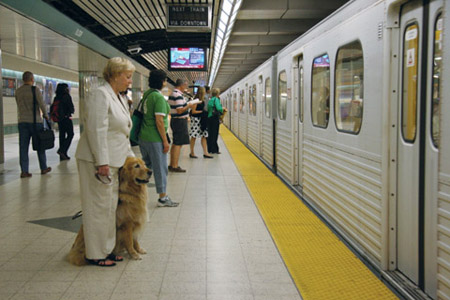
We get a lot of people asking about how the subway extensions will affect the current service and levels of capacity. We understand that extending the line will allow more people to ride and there are plans in place to manage ridership growth and help increase current capacity during peak times, especially at Yonge and Bloor.
Our plan includes opening the Spadina subway extension first to divert riders who begin their commute in the north. We expect this to divert 1,300 peak hour riders away from the Yonge line. There will also be 2,900 parking spaces along the Spadina extension, to divert more riders away from the Yonge line.
A new signaling system will allow trains to run closer together, reducing the wait time between trains. More frequent trains help spread out ridership, reducing the bunching-up effect. The new trains will allow people to walk from one end to the other – making use of space between the train cars that’s currently not possible. In addition, only every second train will go north of Finch Station during the morning peak, meaning every other train arriving at Finch during the morning peak will start its southbound trip empty.
That is a very short overview of some of our plans to increase capacity. Please let me know if you are interested in how any particular plan will work. I like talking about solutions that will make getting around better for everyone.

6 replies on “Increasing subway capacity”
Touche. Solid arguments. Keep uup thee amazing effort.
Unfortunately, that rendering doesn’t do a great job of showing all the amenities the new station will feature. A middle section, which is hard to see in the picture featured on the blog, will be completely enclosed and heated. We will have a full post on many of the new features that will better explain what the indoor section will look like.
Well judging by the released renders. They dont enclosed at all. I Agree Richmond hill Center Needs door’s added, If wind blows from the north or south it goes straight through the waiting “sheltered area”. On all regular YRT bus stops, the wind blows hard at your feet because the bottom is exposed. With the 1/2 open concept the at normal yrt stops, shelter is barly provided. You would think in the 21st century, buss shelters could advanced!! Please dont make the same mistake at richmond hill center and by judging by the renders it will be a cold wait at one of thoes bus stops.
I agree with David in that Richmond Hill Centre has a terrible design in terms of protection from the elements. Having just survived through the recent winter season, I can say confidently that the “protected” areas provide absolutely no protection from wind/rain/snow at all. A redesign is needed as soon as possible, even if it means just covering up the gaping open areas up top and adding doors to the open framed areas.
again who ever designs viva bus stops AND the current Richmond hill center is a moron. We live in CANADA, our winters are windy and cold. Why do our current bus shelters and future shelter’s have NO protection from the wind. Our buss stops look like they are from California. A buss stop needs to work properly before eye candy is applied.
DaleA: Hi David,
Thanks for your comment. The new station canopies we’re designing will keep riders warm and protect them from the wind, snow and cold. We are putting the riders’ comfort first with stations that have heated indoor areas – built especially for our chilly winters. In the coming months, a short video will feature how the design came about and you’ll hear from one of our leading architects.
None of these actions will make Yonge-Bloor station any less crowded. That station is already at capacity, and any more riders due to this extension could pose serious safety hazards.
DaleA: For more information on improvements and/or expansion of TTC stations please read this article and other reports from the TTC.